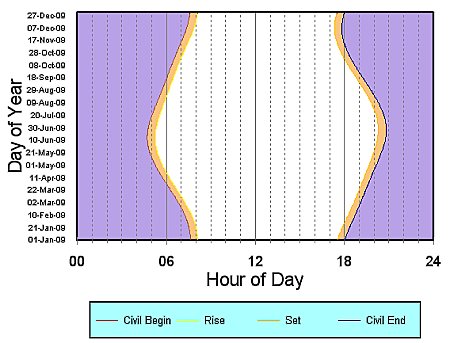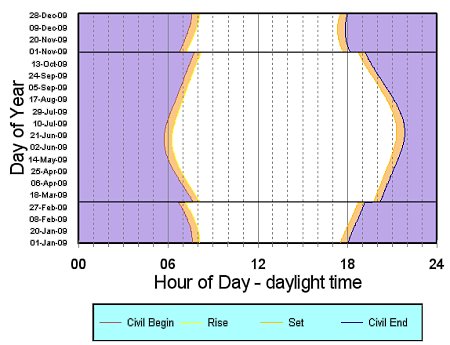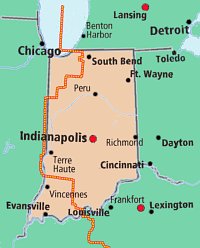Saturday, 07 November 2009
Saving daylight: So, what’s in the account?
(My previous post, mostly about Indiana’s time follies, is here.)
First, a few definitions:
Of the three types of twilight, we who live in urban areas are probably most interested in the first, Civil twilight. Although the sun is below the horizon, during that period there’s still enough sky illumination to allow “normal activities†without artificial lighting. (In Indiana the length of Civil twilight varies between 28 and 33 minutes.) At the end of Civil twilight in the evening, the sky is still light; but if you plan on doing anything outdoors it’s time to turn the lights on. During Nautical twilight sailors at sea can still make out the horizon clearly enough to do star sightings, but for those of us on land things just gradually get darker. By the time we urbanites reach Astronomical twilight any remaining sky illumination has usually been swamped by the glow of city lights.
Now let’s look at Daylight saving, or, rather, let’s first not look at daylight saving. Here’s a plot of the sunrise/sunset and Civil twilight data for Indianapolis for the year 2009. Violet is darkness; the orange bands are the periods of Civil twilight:

With daylight savings added, the plot looks like this:

As you can see, the major result is to extend the working day at the expense of the early morning. But there are some other interesting effects:
If you prefer to “get up with the sun,†it’s harder to do under Daylight savings time. Without DST, if your alarm sounds at 6:30, you’ll awaken to sunshine from April 1 to September 19 (172 days); and with enough light to walk out and get the paper from (roughly) March 14 to October 22 (223 days). Apply DST, and sunrise comes at 6:30 or earlier only on the 63 days from May 15 to July 16, with Civil twilight beginning at 6:30 or earlier from April 21 to August 17 (119 days). A 6 o’clock wakeup is worse: With DST, the sun is never in the sky at 6 or before (without DST: April 20-August 18 - 121 days), and Civil twilight is around for only 66 days, from May 14 to July 18.
You do get more light at the end of the day, just hope you don’t have kids to put to bed: Even without DST the end of Civil twilight (remember, not darkness - that’s half-an-hour later) falls after 8:30 p.m. (2030) from May 22 to July 30. Daylight saving makes the sky Civil-twilight-or-brighter from March 26 to September 9, with the latest end of Civil twilight at 9:50p.m. (2150) on June 26 and 27. The golf courses love it, but pity the drive-in theater operators (or you, if you want to do some weeknight astronomy).
Eastbound drivers on the 7a.m. - 8a.m. morning commute also “benefitted†by getting to face the rising sun four times: Between January 23 (sunrise 8:00) and March 7 (sunrise 7:08, at which point DST kicked in), from March 12 (8:00 daylight time) to April 19th (7:01 daylight), then from August 18 (7:00 daylight) to October 20 (8:00 daylight), with a final round from November 1 (7:14 standard time) to December 22 (8:00 standard). My back-of-the-envelope calculation says DST gives them an extra 96 days of glare (and I wonder how many extra sun-in-the-eyes related accidents)!
then from August 18 (7:00 daylight) to October 20 (8:00 daylight), with a final round from November 1 (7:14 standard time) to December 22 (8:00 standard). My back-of-the-envelope calculation says DST gives them an extra 96 days of glare (and I wonder how many extra sun-in-the-eyes related accidents)!
Homeward commuters don’t have it quite as bad: Drivers headed westbound between 5 and 6 o’clock face the sun for 29 days (from January 1 to January 28), 16 days from March 8 to March 23 (but only if their travel was 5:44 or later), and finally the 61 days from November 1 (when the end of DST moved sunset from 6:43 to 5:43) to the end of the year. Overall, 105 days under daylight, 103 without: A wash, with the only disadvantage the sudden appearance of the setting sun on November 1.
That last congressional revision of DST dates also ensured that the latest sunrise of the year no longer falls in late December, when you might expect it. This year it took place on October 31, at 8:12 a.m.. (The latest December sunrise- actually December 30-January 8- is 8:06 a.m.. The final seven days in October have sunrises at 8:06 daylight or later, moving the end of DST to the first Sunday in November means those sunrises will always occur under daylight time.)
After the jump, “How dark is it?â€
more...
(My previous post, mostly about Indiana’s time follies, is here.)
If you’d like to play along at home, you can download sunrise/twilight tables for the entire year, customized to your location, from the U.S. Naval Observatory at one of these links:
First, a few definitions:
Sunrise and sunset ...the times when the upper edge of the disk of the Sun is on the horizon, considered unobstructed relative to the location of interest. Atmospheric conditions are assumed to be average, and the location is in a level region on the Earth’s surface.
Twilight: Before sunrise and again after sunset there are intervals of time, twilight, during which there is natural light provided by the upper atmosphere, which does receive direct sunlight and reflects part of it toward the Earth’s surface.
Civil twilight is defined to begin in the morning, and to end in the evening when the center of the Sun is geometrically 6 degrees below the horizon. This is the limit at which twilight illumination is sufficient, under good weather conditions, for terrestrial objects to be clearly distinguished; at the beginning of morning civil twilight, or end of evening civil twilight, the horizon is clearly defined and the brightest stars are visible under good atmospheric conditions in the absence of moonlight or other illumination. In the morning before the beginning of civil twilight and in the evening after the end of civil twilight, artificial illumination is normally required to carry on ordinary outdoor activities.
Nautical twilight is defined to begin in the morning, and to end in the evening, when the center of the sun is geometrically 12 degrees below the horizon. At the beginning or end of nautical twilight, under good atmospheric conditions and in the absence of other illumination, general outlines of ground objects may be distinguishable, but detailed outdoor operations are not possible, and the horizon is indistinct.
Astronomical twilight is defined to begin in the morning, and to end in the evening when the center of the Sun is geometrically 18 degrees below the horizon. Before the beginning of astronomical twilight in the morning and after the end of astronomical twilight in the evening the Sun does not contribute to sky illumination...
Twilight: Before sunrise and again after sunset there are intervals of time, twilight, during which there is natural light provided by the upper atmosphere, which does receive direct sunlight and reflects part of it toward the Earth’s surface.
Civil twilight is defined to begin in the morning, and to end in the evening when the center of the Sun is geometrically 6 degrees below the horizon. This is the limit at which twilight illumination is sufficient, under good weather conditions, for terrestrial objects to be clearly distinguished; at the beginning of morning civil twilight, or end of evening civil twilight, the horizon is clearly defined and the brightest stars are visible under good atmospheric conditions in the absence of moonlight or other illumination. In the morning before the beginning of civil twilight and in the evening after the end of civil twilight, artificial illumination is normally required to carry on ordinary outdoor activities.
Nautical twilight is defined to begin in the morning, and to end in the evening, when the center of the sun is geometrically 12 degrees below the horizon. At the beginning or end of nautical twilight, under good atmospheric conditions and in the absence of other illumination, general outlines of ground objects may be distinguishable, but detailed outdoor operations are not possible, and the horizon is indistinct.
Astronomical twilight is defined to begin in the morning, and to end in the evening when the center of the Sun is geometrically 18 degrees below the horizon. Before the beginning of astronomical twilight in the morning and after the end of astronomical twilight in the evening the Sun does not contribute to sky illumination...
Of the three types of twilight, we who live in urban areas are probably most interested in the first, Civil twilight. Although the sun is below the horizon, during that period there’s still enough sky illumination to allow “normal activities†without artificial lighting. (In Indiana the length of Civil twilight varies between 28 and 33 minutes.) At the end of Civil twilight in the evening, the sky is still light; but if you plan on doing anything outdoors it’s time to turn the lights on. During Nautical twilight sailors at sea can still make out the horizon clearly enough to do star sightings, but for those of us on land things just gradually get darker. By the time we urbanites reach Astronomical twilight any remaining sky illumination has usually been swamped by the glow of city lights.
Now let’s look at Daylight saving, or, rather, let’s first not look at daylight saving. Here’s a plot of the sunrise/sunset and Civil twilight data for Indianapolis for the year 2009. Violet is darkness; the orange bands are the periods of Civil twilight:

With daylight savings added, the plot looks like this:

As you can see, the major result is to extend the working day at the expense of the early morning. But there are some other interesting effects:
If you prefer to “get up with the sun,†it’s harder to do under Daylight savings time. Without DST, if your alarm sounds at 6:30, you’ll awaken to sunshine from April 1 to September 19 (172 days); and with enough light to walk out and get the paper from (roughly) March 14 to October 22 (223 days). Apply DST, and sunrise comes at 6:30 or earlier only on the 63 days from May 15 to July 16, with Civil twilight beginning at 6:30 or earlier from April 21 to August 17 (119 days). A 6 o’clock wakeup is worse: With DST, the sun is never in the sky at 6 or before (without DST: April 20-August 18 - 121 days), and Civil twilight is around for only 66 days, from May 14 to July 18.
You do get more light at the end of the day, just hope you don’t have kids to put to bed: Even without DST the end of Civil twilight (remember, not darkness - that’s half-an-hour later) falls after 8:30 p.m. (2030) from May 22 to July 30. Daylight saving makes the sky Civil-twilight-or-brighter from March 26 to September 9, with the latest end of Civil twilight at 9:50p.m. (2150) on June 26 and 27. The golf courses love it, but pity the drive-in theater operators (or you, if you want to do some weeknight astronomy).
Eastbound drivers on the 7a.m. - 8a.m. morning commute also “benefitted†by getting to face the rising sun four times: Between January 23 (sunrise 8:00) and March 7 (sunrise 7:08, at which point DST kicked in), from March 12 (8:00 daylight time) to April 19th (7:01 daylight),
 then from August 18 (7:00 daylight) to October 20 (8:00 daylight), with a final round from November 1 (7:14 standard time) to December 22 (8:00 standard). My back-of-the-envelope calculation says DST gives them an extra 96 days of glare (and I wonder how many extra sun-in-the-eyes related accidents)!
then from August 18 (7:00 daylight) to October 20 (8:00 daylight), with a final round from November 1 (7:14 standard time) to December 22 (8:00 standard). My back-of-the-envelope calculation says DST gives them an extra 96 days of glare (and I wonder how many extra sun-in-the-eyes related accidents)!Homeward commuters don’t have it quite as bad: Drivers headed westbound between 5 and 6 o’clock face the sun for 29 days (from January 1 to January 28), 16 days from March 8 to March 23 (but only if their travel was 5:44 or later), and finally the 61 days from November 1 (when the end of DST moved sunset from 6:43 to 5:43) to the end of the year. Overall, 105 days under daylight, 103 without: A wash, with the only disadvantage the sudden appearance of the setting sun on November 1.
That last congressional revision of DST dates also ensured that the latest sunrise of the year no longer falls in late December, when you might expect it. This year it took place on October 31, at 8:12 a.m.. (The latest December sunrise- actually December 30-January 8- is 8:06 a.m.. The final seven days in October have sunrises at 8:06 daylight or later, moving the end of DST to the first Sunday in November means those sunrises will always occur under daylight time.)
After the jump, “How dark is it?â€
more...
Posted by: Old Grouch in
Rants
at
22:37:53 GMT
| Comments (1)
| Add Comment
Post contains 1887 words, total size 53 kb.
Monday, 02 November 2009
Saving daylight: What time is it?
This past weekend, most of us in the United States[1] engaged in the biannual ritual of adjusting our clocks, this time to accommodate the end of daylight savings time. Of course DST doesn’t actually save any daylight, it just moves it around a little. Here in Indianapolis our sunrise moved from shortly after 8am to shortly after 7, while this evening’s sunset will be at a-quarter-to-six. One might ask if all the clock-adjusting is worth it?
Congress seems to think so. In fact, as is the case with many of the nostrums advocated by our Washington solons, their opinion appears to be “if a little is good, then even more will be better.†Twice in the last 50 years, in the name of “conserving energy,†Congress extended the daylight time period: First during the 1970s energy “crisis,†when it set the 1974 starting date at January 6th and the 1975 starting date February 23rd, and again with 2005’s Energy Policy Act, which (effective 2007) both advanced the starting day (moved to the second Sunday in March from the last Sunday in April), and delayed the ending day (previously, the last Sunday in October, delayed until the first Sunday in November ). Under this current regime, we are now “saving daylight†for 238 of the year’s 365 days.
The question of “What time is it?†has long been a bone of contention in Indiana. Logically, the division between the eastern and central time zones should fall at about 85° longitude, close to the state’s eastern border. But the cities of Indianapolis, South Bend, and Fort Wayne have always looked eastward (out of commercial ties and aspirations of becoming “major metrosâ€), while the corners near Chicago and Cincinnati, along with the southwestern counties around Evansville, prefer to align their time with the adjacent states. In 1918, Congress placed Indiana in the Central time zone, but over time the boundary crept westward, accompanied by legislative action, court cases, popular uproar, and civil disobedience.[2] The federal Uniform Time Act of 1966, which (again) attempted to put the entire state in one time zone, only reignited the confusion. Finally, in the late 60s, an informal compromise was reached which put the state’s northwest and southwest corners in the Central zone, observing daylight time, and set the rest of the state’s clocks to Eastern time, but with no daylight savings.[3] This arrangement was finally ratified by the state legislature (over the governor’s veto) and the U.S. Congress in 1966.
Why no daylight time? Aside from stubbornness and distrust on the part of the citizenry, the part of the state that observed eastern time could be thought of as already being on daylight time- all year around (when compared to the 1918 division)[4]. And there was some truth in this: In Indianapolis, Eastern Standard time means sunsets as late as 8:20pm, with civil twilight[5] continuing until almost 9:00. Entertainment interests, specifically the Theater Owners of Indiana, lobbied the legislature against daylight time (with daylight-savings sunsets as late as 9:20, drive-ins would have been unable to start their programs until shortly before 10pm). They were joined by the farmers, who, operating by the sun, saw no reason to move their clocks back and forth. Others were less satisfied.[6]
The 1966 compromise held- mostly- until 2005, when Governor Mitch Daniels, spurred by businesses complaining that their customers “could never tell what time we’re on,†re-opened the can of worms by including a statewide daylight time provision in an economic development package. This time it passed, and Indiana has observed daylight time throughout the state since 2006, although with some jockeying of the boundary between Eastern and Central.

Next: Now what?
Elsewhere:
-----
This past weekend, most of us in the United States[1] engaged in the biannual ritual of adjusting our clocks, this time to accommodate the end of daylight savings time. Of course DST doesn’t actually save any daylight, it just moves it around a little. Here in Indianapolis our sunrise moved from shortly after 8am to shortly after 7, while this evening’s sunset will be at a-quarter-to-six. One might ask if all the clock-adjusting is worth it?
Congress seems to think so. In fact, as is the case with many of the nostrums advocated by our Washington solons, their opinion appears to be “if a little is good, then even more will be better.†Twice in the last 50 years, in the name of “conserving energy,†Congress extended the daylight time period: First during the 1970s energy “crisis,†when it set the 1974 starting date at January 6th and the 1975 starting date February 23rd, and again with 2005’s Energy Policy Act, which (effective 2007) both advanced the starting day (moved to the second Sunday in March from the last Sunday in April), and delayed the ending day (previously, the last Sunday in October, delayed until the first Sunday in November ). Under this current regime, we are now “saving daylight†for 238 of the year’s 365 days.
The question of “What time is it?†has long been a bone of contention in Indiana. Logically, the division between the eastern and central time zones should fall at about 85° longitude, close to the state’s eastern border. But the cities of Indianapolis, South Bend, and Fort Wayne have always looked eastward (out of commercial ties and aspirations of becoming “major metrosâ€), while the corners near Chicago and Cincinnati, along with the southwestern counties around Evansville, prefer to align their time with the adjacent states. In 1918, Congress placed Indiana in the Central time zone, but over time the boundary crept westward, accompanied by legislative action, court cases, popular uproar, and civil disobedience.[2] The federal Uniform Time Act of 1966, which (again) attempted to put the entire state in one time zone, only reignited the confusion. Finally, in the late 60s, an informal compromise was reached which put the state’s northwest and southwest corners in the Central zone, observing daylight time, and set the rest of the state’s clocks to Eastern time, but with no daylight savings.[3] This arrangement was finally ratified by the state legislature (over the governor’s veto) and the U.S. Congress in 1966.
Why no daylight time? Aside from stubbornness and distrust on the part of the citizenry, the part of the state that observed eastern time could be thought of as already being on daylight time- all year around (when compared to the 1918 division)[4]. And there was some truth in this: In Indianapolis, Eastern Standard time means sunsets as late as 8:20pm, with civil twilight[5] continuing until almost 9:00. Entertainment interests, specifically the Theater Owners of Indiana, lobbied the legislature against daylight time (with daylight-savings sunsets as late as 9:20, drive-ins would have been unable to start their programs until shortly before 10pm). They were joined by the farmers, who, operating by the sun, saw no reason to move their clocks back and forth. Others were less satisfied.[6]
The 1966 compromise held- mostly- until 2005, when Governor Mitch Daniels, spurred by businesses complaining that their customers “could never tell what time we’re on,†re-opened the can of worms by including a statewide daylight time provision in an economic development package. This time it passed, and Indiana has observed daylight time throughout the state since 2006, although with some jockeying of the boundary between Eastern and Central.

Next: Now what?
Elsewhere:
timeanddate.com: Indiana’s Time Zones and Daylight Savings Time
Wikipedia article: Time in Indiana
MCCSC.edu: What Time Is It in Indiana?
U.S. Naval Observatory: Daylight Time
Wikipedia article: Time in Indiana
MCCSC.edu: What Time Is It in Indiana?
U.S. Naval Observatory: Daylight Time
-----
[1] except for “parts of the state of Arizona, and the state of Hawaiiâ€
[2] The author recalls the year 1961: After the legislature had (again) thrown up its hands at trying to sort things out, the (federal) Interstate Commerce Commission attempted to impose a boundary. In Indianapolis, which the commission put in the Central zone, government agencies and schools set their clocks to the “official†time (as did Weir Cook Airport, where clocks were labeled “Official Airline Timeâ€), but most businesses ant the public ignored it and operated on Eastern Standard.
[3] The counties near Cincinnati got “a wink and a nod†allowing them to “informally†set their clocks to match Ohio.
[4] Talk about forward-looking by being behind! “I wish it went year-round.†- Glenn Reynolds
[5] “...The limit at which twilight illumination is sufficient, under good weather conditions, for terrestrial objects to be clearly distinguished; at the beginning of morning civil twilight, or end of evening civil twilight, the horizon is clearly defined and the brightest stars are visible under good atmospheric conditions in the absence of moonlight or other illumination. In the morning before the beginning of civil twilight and in the evening after the end of civil twilight, artificial illumination is normally required to carry on ordinary outdoor activities†- source
[6] Television broadcasters, for one. If the state didn’t observe daylight time, they faced the problem of what to do when the rest of the country switched, because during the daylight time period, the entire network schedule would (effectively) be moved ahead by one hour. That would put the 6pm local news at 5pm (when most of the audience was just getting off from work), and Johnny Carson on an hour early, at 10:30. Most of the stations eventually “solved†the problem by allowing the daytime shows to move, but delaying prime time programs locally (except for live events such as baseball games). I do recall, however, at least one year when some of the Indianapolis network affiliates elected to run the evening programs as received, which made their schedules out of “sync†with the others. Putting all those operating hours on their then-standard quadruplex video tape machines was expensive, so in 1968 the broadcasters filed suit in an attempt to force the ICC to require daylight time. They lost.
[2] The author recalls the year 1961: After the legislature had (again) thrown up its hands at trying to sort things out, the (federal) Interstate Commerce Commission attempted to impose a boundary. In Indianapolis, which the commission put in the Central zone, government agencies and schools set their clocks to the “official†time (as did Weir Cook Airport, where clocks were labeled “Official Airline Timeâ€), but most businesses ant the public ignored it and operated on Eastern Standard.
[3] The counties near Cincinnati got “a wink and a nod†allowing them to “informally†set their clocks to match Ohio.
[4] Talk about forward-looking by being behind! “I wish it went year-round.†- Glenn Reynolds
[5] “...The limit at which twilight illumination is sufficient, under good weather conditions, for terrestrial objects to be clearly distinguished; at the beginning of morning civil twilight, or end of evening civil twilight, the horizon is clearly defined and the brightest stars are visible under good atmospheric conditions in the absence of moonlight or other illumination. In the morning before the beginning of civil twilight and in the evening after the end of civil twilight, artificial illumination is normally required to carry on ordinary outdoor activities†- source
[6] Television broadcasters, for one. If the state didn’t observe daylight time, they faced the problem of what to do when the rest of the country switched, because during the daylight time period, the entire network schedule would (effectively) be moved ahead by one hour. That would put the 6pm local news at 5pm (when most of the audience was just getting off from work), and Johnny Carson on an hour early, at 10:30. Most of the stations eventually “solved†the problem by allowing the daytime shows to move, but delaying prime time programs locally (except for live events such as baseball games). I do recall, however, at least one year when some of the Indianapolis network affiliates elected to run the evening programs as received, which made their schedules out of “sync†with the others. Putting all those operating hours on their then-standard quadruplex video tape machines was expensive, so in 1968 the broadcasters filed suit in an attempt to force the ICC to require daylight time. They lost.
Posted by: Old Grouch in
Rants
at
14:33:01 GMT
| No Comments
| Add Comment
Post contains 1024 words, total size 9 kb.
<< Page 1 of 1 >>
84kb generated in CPU 0.0133, elapsed 0.1154 seconds.
51 queries taking 0.1067 seconds, 162 records returned.
Powered by Minx 1.1.6c-pink.
51 queries taking 0.1067 seconds, 162 records returned.
Powered by Minx 1.1.6c-pink.














